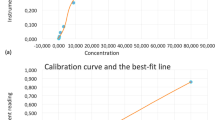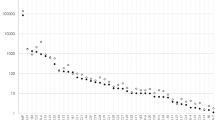Abstract
Aims
To compare the vitreous levels of chemokines in diabetic patients with and without retinopathy. To find the relationship between stages of diabetic retinopathy (DR) and levels of vitreous chemokines.
Methods
The study involved 20 non-diabetic and 20 diabetic patients without clinical signs of DR (NDR) and 40 diabetic patients with proliferative diabetic retinopathy (PDR). The vitreous humor was collected and the levels of 40 chemokines were measured using magnetic color-bead-based multiplex assay.
Results
The control group, NDR group, PDR with vitreous hemorrhage (VH) group, and PDR with tractional retinal detachment group comprised 20, 20, 21, and 19 eyes, respectively. Only the concentration of CCL3 was significantly higher in the NDR group compared with the controls (p = 0.038). Twenty-five types of chemokines were statistically higher in the PDR with VH group in comparison to NDR group (all p < 0.05). All chemokines were statistically higher in the PDR with TRD group in comparison to NDR group (all p < 0.05) apart from 3 chemokines: GM-CSF, MIF, and CCL3(p = 0.086, p = 0.109, p = 0.094, respectively). The concentration of CCL21, CCL15 in PDR with TRD group was significantly higher compared with PDR with VH group, while other 36 chemokines were not significantly different between PDR with VH group and PDR with TRD group.
Conclusions
The inflammation gradually worsen with the progression of DR. CCL3 may be associated with the onset of early diabetic retinal damage, and CCL15 and CCL21 may be closely related to the formation of fibrovascular membrane and the progression of the end stage of DR.


Similar content being viewed by others
References
Yau JWY, Rogers S, Kawasaki R et al (2012) Global prevalence and major risk factors of diabetic retinopathy. Diabetes Care 35(3):556–564
Shaw JE, Sicree R, Zimmet P (2010) Global estimates of the prevalence of diabetes for 2010 and 2030. Diabetes Res Clin Pract 87(1):4–14
Trick GL, Burde RM, Cordon MO, Santiago JV, Kilo C (1988) The relationship between hue discrimination and contrast sensitivity deficits in patients with diabetes mellitus. Ophthalmology 95(5):693–698
Kurtenbach A, Wagner U, Neu A, Schiefer U, Ranke MB, Zrenner E (1994) Brightness matching and colour discrimination in young diabetics without retinopathy. Vision Res 34(1):115–122
Agemy S, Scripsema N, Shah CM et al (2015) Retinal vascular perfusion density mapping using optical coherence tomography angiography in normals and diabetic retinopathy patients. Retina J Retinal Vitreous Dis 35 (11):2353–2363
Cao D, Yang D, Huang Z et al (2018) Optical coherence tomography angiography discerns preclinical diabetic retinopathy in eyes of patients with type 2 diabetes without clinical diabetic retinopathy. Acta Diabetol 55(5):469–477
Semeraro F, Cancarini A, Dellomo R, Rezzola S, Romano M, Costagliola C (2015) Diabetic retinopathy: vascular and inflammatory disease. Exp Diabetes Res 2015:582060–582060
Semeraro F, Cancarini A, dell’Omo R, Rezzola S, Romano MR, Costagliola C (2015) Diabetic retinopathy: vascular and inflammatory disease. J Diabetes Res 2015:582060. https://doi.org/10.1155/2015/582060
Vujosevic S, Simo R (2017) Local and systemic inflammatory biomarkers of diabetic retinopathy: an integrative approach. Investig Ophthalmol Vis Sci 58(6)
Cheung CMG, Vania M, Ang M, Chee SP, Li J (2012) Comparison of aqueous humor cytokine and chemokine levels in diabetic patients with and without retinopathy. Mol Vis 18:830–837
Dong N, Xu B, Wang B, Chu L (2013) Study of 27 aqueous humor cytokines in patients with type 2 diabetes with or without retinopathy. Mol Vis 19:1734–1746
Wu H, Hwang D, Song X, Tao Y (2017) Association between Aqueous Cytokines and diabetic retinopathy stage. J Ophthalmol 2017:1–8
Dimberg A (2010) Chemokines in angiogenesis. Curr Top Microbiol Immunol 341:59–80
Diagnosis and Classification of Diabetes Mellitus (2014) Diabetes Care 37(Supplement 1):S81
Wilkinson CP, Ferris FL, Klein R, et al. (2003) Proposed international clinical diabetic retinopathy and diabetic macular edema disease severity scales. Ophthalmology 110(9):1677–1682
Ecker SM, Hines JC, Pfahler SM, Glaser BM (2011) Aqueous cytokine and growth factor levels do not reliably reflect those levels found in the vitreous. Mol Vis 17(14):2856–2863
Szklarczyk D, Franceschini A, Wyder S, et al. (2015) STRING v10: protein–protein interaction networks, integrated over the tree of life. Nucleic Acids Res 43(Database issue):D447–D452. https://doi.org/10.1093/nar/gku1003
Vujosevic S, Micera A, Bini S, Berton M, Esposito G, Midena E (2016) Proteome analysis of retinal glia cells-related inflammatory cytokines in the aqueous humour of diabetic patients. Acta Ophthalmol 94(1):56–64
Hang H, Yuan S, Yang Q, Yuan D, Liu Q (2014) Multiplex bead array assay of plasma cytokines in type 2 diabetes mellitus with diabetic retinopathy. Mol Vis 20:1137–1145
Elasrar AMA, Struyf S, Kangave D, Geboes K, Van Damme J (2006) Chemokines in proliferative diabetic retinopathy and proliferative vitreoretinopathy. Eur Cytokine Netw 17(3):155–165
Capeans C, Mv DR, Lojo S, Salorio MS (1998) C-C chemokines in the vitreous of patients with proliferative vitreoretinopathy and proliferative diabetic retinopathy. Retina J Retinal Vitreous Dis 18(6):546–550
Kohno H, Maeda T, Perusek L, Pearlman E, Maeda A (2014) CCL3 production by microglial cells modulates disease severity in murine models of retinal degeneration. J Immunol 192(8):3816–3827
De Moraes G, Layton CJ (2016) Therapeutic targeting of diabetic retinal neuropathy as a strategy in preventing diabetic retinopathy. Clin Exp Ophthalmol 44(9):838–852
Blum A, Pastukh N, Socea D, Jabaly H (2017) Levels of adhesion molecules in peripheral blood correlat with stages of diabetic retinopathy and may serve as bio markers for microvascular complications. Cytokine 106:76–79
Tsai T, Kuehn S, Tsiampalis N et al (2018) Anti-inflammatory cytokine and angiogenic factors levels in vitreous samples of diabetic retinopathy patients. PloS One 13 (3)
Wang Y, Fan L, Meng X et al (2016) Transplantation of IL-10-transfected endothelial progenitor cells improves retinal vascular repair via suppressing inflammation in diabetic rats. Graefes Arch Clin Exp Ophthalmol 254(10):1957–1965
Chen H, Zhang X, Liao N, Wen F (2017) Assessment of biomarkers using multiplex assays in aqueous humor of patients with diabetic retinopathy. BMC Ophthalmol 17(1):176
Xie M, Hu A, Luo Y, Sun W, Hu X, Tang S (2014) Interleukin-4 and melatonin ameliorate high glucose and interleukin-1β stimulated inflammatory reaction in human retinal endothelial cells and retinal pigment epithelial cells. Molecular Vision 20:921–928
Hwang J, Kim CW, Son KN et al (2004) Angiogenic activity of human CC chemokine CCL15 in vitro and in vivo. FEBS Lett 570(1):47–51
Shan Z, Xu B, Mikulowskamennis A, Michie SA (2014) CCR7 directs the recruitment of T cells into inflamed pancreatic islets of nonobese diabetic (NOD) mice. Immunol Res 58:351–357
Bonacchi A, Petrai I, Defranco R et al (2003) The Chemokine CCL21 Modulates Lymphocyte Recruitment and Fibrosis in Chronic Hepatitis C. Gastroenterology 125(4):1060–1076
Pierce EM, Carpenter K, Jakubzick C et al (2007) Idiopathic pulmonary fibrosis fibroblasts migrate and proliferate to CC chemokine ligand 21. Eur Respir J 29(6):1082–1093
Wada T, Sakai N, Matsushima K, Kaneko S (2007) Fibrocytes: A new insight into kidney fibrosis. Kidney Int 72(3):269–273
Acknowledgements
This study was funded by National Natural Science Foundation of China (Grant Number 81500737) and Guangzhou Science and Technology Program (Grant Number 201607010343). The sponsors or funding organizations had no role in the design or conduct of this research.
Author information
Authors and Affiliations
Corresponding author
Ethics declarations
Conflict of interest
The authors declare that they have no competing interests.
Ethical standard statement
This study was performed in accordance to the tenets of the Declaration of Helsinki and approved by the local Research Ethics Committee of the Guangdong Provincial People’s Hospital (Number 2016232A).
Informed consent
Informed consent was obtained from the subjects.
Additional information
Managed by Massimo Federici.
Publisher’s Note
Springer Nature remains neutral with regard to jurisdictional claims in published maps and institutional affiliations.
Rights and permissions
About this article
Cite this article
Zeng, Y., Cao, D., Yu, H. et al. Comprehensive analysis of vitreous humor chemokines in type 2 diabetic patients with and without diabetic retinopathy. Acta Diabetol 56, 797–805 (2019). https://doi.org/10.1007/s00592-019-01317-6
Received:
Accepted:
Published:
Issue Date:
DOI: https://doi.org/10.1007/s00592-019-01317-6




